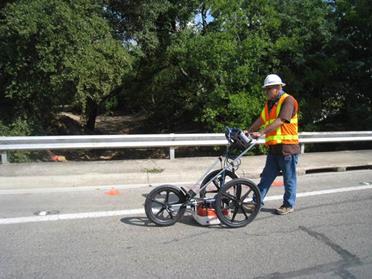4.6 Ground-coupled Penetrating Radar (GPR)
GPR systems using lower-frequency antennae are able to discern anomalies deeper within the pavement structure. Resolution is improved when the systems are placed in contact with the surface, so the antenna is pushed by buggy or dragged behind a van that houses the data acquisition system. Typical antennae frequencies used by the department range from 200 MHz to 2.5 GHz. Maximum penetration will vary with antenna frequency, soil type, and degree of saturation. Higher antenna frequency will provide lower penetration, but higher near-surface resolution. Under the right conditions, the 200 MHz antenna can penetrate up to 30 ft.; however, with this lower frequency, there is poor near-surface resolution of layers. These systems have been used successfully in locating buried fuel tanks, archeological burial sites, sink holes, rebar during coring, voids under pavement slabs, honeycombing in concrete, pavement thickness above rebar, and aquatic springs within the right-of-way. The systems and the required data analysis remain specialized; services are available through MNT – Pavement Asset Management or through an interagency contract with the Texas A&M Transportation Institute (TTI).

Figure 4-10. 200 MHz Ground-coupled Penetrating Radar.

Figure 4-11. 400 MHz Ground-coupled Penetrating Radar.